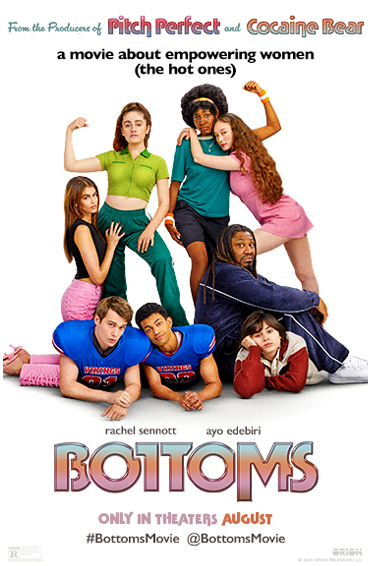
(Courtesy MGM Studios)
This past summer, I proposed to my parents that we watch Emma Seligman’s comedy thriller “Shiva Baby” (2020). I waited for years since its release, fearful of my choice falling flat at their feet. I concentrated as much on my parents’ reactions as I did on the movie until the first guffaws broke out, to my great relief. We continued to laugh together at the same jokes, a proper blend of situational comedy and nail-biting anxiety. This felt like nothing short of a miracle after countless failures in the course of my lifetime to bridge our comedic differences.
One generation’s attempt at catering to another generation almost always comes out as a caricature. Schisms in humor continue to widen between each generation, simultaneously moving along a conveyor belt where one trend is tossed for the next at a moment’s notice. Consequently, a bonafide “funny” movie is a rare commodity these days.
Then came “Bottoms.” Not only does this fresh movie have Seligman’s fingerprints all over it, but Rachel Sennott — the “Shiva Baby” and “Bodies Bodies Bodies” (2022) star — plays a primary role in the film alongside Ayo Edebiri, a past creative collaborator of hers in “Ayo and Rachel are Single” (2020). Among these comedic powerhouses are eclectic cast members like Ruby Cruz, Marshawn Lynch and Nicholas Galitzine. My expectations were high after getting a nice taste of the film’s ridiculousness and vulgarity as early as its first trailer, and I was not disappointed..
“Bottoms” takes the classic high school movie trope of loser-turned-hero who “gets the girl,” hollows it out and stuffs it with satire, violence and lots of queer women. The movie drops you right into the thick of it: I initially struggled to adjust to the clichéd lines and delivery, but the feeling dissipated as quickly as the chaos I paid for arrived.
My screening of “Bottoms” soon filled with giggles and cackles alike, all thanks to a golden ratio of funny: ostentatious melodrama, digestible offensiveness, tasteful slapstick bits, hidden jokes and expert comedic timing. The premise of high school girls starting a principal-approved fight club is outlandish enough that viewers such as myself were inundated, ready to accept whatever craziness lies ahead.
The football players, the primary antagonists that oppose Sennott and Edebiri’s characters, are reduced to horny jocks whose sports uniforms fuse with their personalities. This fixation reduces them to something akin to depravity; in select scenes, viewers can spot one of the background players in an iron cage sequestered to the corner of the classroom. This bizarre, if not wholly illogical world, is delivered in a deadpan fashion, with many of its priceless Easter eggs laid in the background of each jam-packed scene. It becomes natural in between each joke to search around and find something equally as ridiculous as everything else in “Bottoms,” like the school mascot costume festooned with egregiously giant genitalia or a casual massacre of football players on the field.
As for the humor itself, I first worried that “Bottoms” would introduce stale, trend-contingent jokes. Offensive humor elicited the brunt of my and the theater’s laughter, often poking at Queer and feminist culture. As a lesbian, I did not mind the commentary’s nature, in part due to the lighthearted tone as well as Seligman herself providing a queer perspective. Slurs are infrequent, but used without harming the characters they address. They instead nod at the Queer experience. In truth, I found great reprieve in the levity “Bottoms” lifts against the harsh reality many LGBTQIA+ folks have to face.
Violence turns out to be a tactful avenue for slapstick comedy, in addition to managing the film’s tone. A fist fight between the school’s cheerleading captain and a nerd, both unversed in combat, is a moment I never thought I would ever witness but am glad I did. “Bottoms” deftly hops between the mild and the severe. When the laughs start to hamper attempts at an overarching narrative, a disturbing scene can sober an audience up quickly.
Moreover, I appreciated how Seligman did justice to sapphic romance, cheesy as it was. Tender moments between love interests required some time to register seriously. Regardless, countless gay plotlines in film and television meet disastrous fates. A happy ending for two girls in love, notwithstanding surrounding craziness and fight clubs, is a special victory for someone like me. Still, Seligman cared enough to portray the other side of the sapphism: unrequited love for a straight girl, a painful but all-too-relatable experience.
I applaud Seligman once again for a refreshing comedy that, similar to its predecessor, embarks on uncharted waters to generate some quality laughs. One can only imagine which genres she will mash together in her subsequent films.





